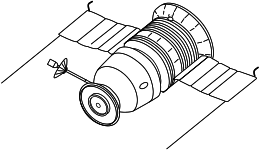
Back زوند 6 Arabic Зонд-6 Byelorussian Зонд 6 Bulgarian Zond 6 Czech Zond 6 French जोंड 6 Hindi Zond–6 Hungarian Զոնդ-6 Armenian Zond 6 ID Zond 6 Italian
 | |||||||||
| Names | Soyuz 7K-L1 s/n 12 | ||||||||
|---|---|---|---|---|---|---|---|---|---|
| Mission type | Planetary Science | ||||||||
| Operator | Lavochkin | ||||||||
| COSPAR ID | 1968-101A | ||||||||
| SATCAT no. | 03535 | ||||||||
| Mission duration | 7 days | ||||||||
| Spacecraft properties | |||||||||
| Manufacturer | NPO Energia Company [citation needed] | ||||||||
| Launch mass | 5,375 kg (11,850 lb)[1] | ||||||||
| Start of mission | |||||||||
| Launch date | 19:11:31, 10 November 1968 (UTC)[1] | ||||||||
| Rocket | Proton-K/11S824 | ||||||||
| Launch site | Baikonur 81/26 | ||||||||
| End of mission | |||||||||
| Disposal | Crash landed | ||||||||
| Landing date | 17 November 1968 14:10 UT[1] | ||||||||
| Landing site | 70 km NE of Tyuratam, Kazakhstan, USSR[2] | ||||||||
| Orbital parameters | |||||||||
| Perigee altitude | 120 km (75 mi) | ||||||||
| Apogee altitude | 400,000 km (250,000 mi) | ||||||||
| Inclination | 51.5° | ||||||||
| Period | 500 days | ||||||||
| Flyby of Moon | |||||||||
| Closest approach | 14 November 1968 | ||||||||
| Distance | 2,420 km (1,500 mi) | ||||||||
| |||||||||
Zond 6 was a formal member of the Soviet Zond program, and an unpiloted version of the Soyuz 7K-L1 crewed Moon-flyby spacecraft. It was launched on a lunar flyby mission on November 10, 1968, from a parent satellite (68-101B) in Earth parking orbit. The spacecraft carried a biological payload of turtles, flies, and bacteria. It also carried scientific probes including cosmic ray, micrometeoroid detectors, and photographic equipment.[3]
The mission was a precursor to a crewed circumlunar flight which the Soviets hoped could occur in December 1968, thus beating the American Apollo 8. However, after rounding the Moon on November 14, Zond 6 crashed on its return to Earth, due to a parachute failure when the parachute was detached from the capsule too early.
- ^ a b c Siddiqi, Asif A. (2018). "Zond 6". Beyond Earth: A Chronicle of Deep Space Exploration, 1958–2016 (PDF) (second ed.). NASA History Program Office. pp. 81–82.
- ^ "Zond-6: Racing Apollo-8". www.russianspaceweb.com. Retrieved 29 July 2019.
- ^ "NASA - NSSDCA - Spacecraft - Details". nssdc.gsfc.nasa.gov. Retrieved 29 January 2024.
© MMXXIII Rich X Search. We shall prevail. All rights reserved. Rich X Search